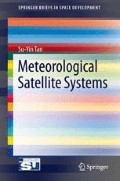Abstract
To date, direct benefits derived from operational meteorological systems have been witnessed in meteorology, climatology, and oceanography applications. The rapid evolution of meteorological satellites led to improved observation of Earth’s environment and more accurate forecasts of the weather, especially of hazards and extreme weather events. Changes in weather and climate can significantly impact our economy, infrastructure, and daily lives.
“Climate is what we expect,
weather is what we get.”
—Mark Twain (1835–1910)
Access this chapter
Tax calculation will be finalised at checkout
Purchases are for personal use only
References
WMO: http://www.wmo.int/pages/prog/amp/pwsp/Nowcasting.htm. Accessed 12 Aug 2013
EUMETSAT: http://www.eumetsat.int/website/home/Satellites/CurrentSatellites/Meteosat/RapidScanningService/index.html. Accessed 12 Aug 2013
NOAA: Nowcasting the Wind Speed during a Hurricane at Sea. Mariners Weather Log. Spring/Summer 47(1) (2003)
NOAASIS: http://www.noaasis.noaa.gov/NOAASIS/ml/future.html. Accessed 12 Aug 2013
GOES-R: http://wwhw.goes-r.gov/spacesegment/glm.html. Accessed 12 Aug 2013
Demaria, M., Demaria, R. T., Knaff, J. A., Molenar, D.: Tropical Cyclone Lightning and Rapid Intensity Change. Monthly Weather Review, 140, 1828–1842 (2012)
Bloom, H. J.: Next Generation Geostationary Operational Environmental Satellite: GOES-R, the United States’ Advanced Weather Sentinel. Proceedings of SPIE, vol. 7458 745802–1 (2009)
GOES-R: http://www.goes-r.gov/spacesegment/glm.html. Accessed 12 Aug 2013
GOES-R: http://www.goes-r.gov/spacesegment/glm-lightning-detect.html. Accessed 12 Aug 2013
NOAA: http://www.jpss.noaa.gov. Accessed 12 Aug 2013
EUMETSAT: Meteosat Third Generation: Europe’s Future Geostationary Meteorological Satellite System. Brochure PRG.FS.01.V.2. (2012)
EUMETSAT: http://www.eumetsat.int/website/home/Satellites/FutureSatellites/MeteosatThirdGeneration/MTGDesign/index.html. Accessed 12 Aug 2013
EUMETSAT: http://www.eumetsat.int/website/home/Satellites/FutureSatellites/EUMETSATPolarSystemSecondGeneration/index.html. Accessed 12 Aug 2013
Schlussel, P.: EUMETSAT Polar System – Second Generation. Presentation, EUM/MET/VWG/12/0160, Issue 1 (2012)
eoPortal: https://directory.eoportal.org/web/eoportal/satellite-missions/f/fy-3. Accessed 12 Aug 2013
eoPortal: https://directory.eoportal.org/web/eoportal/satellite-missions/e/electro-l. Accessed 12 Aug 2013
JMA: http://mscweb.kishou.go.jp/himawari89/index.html. Accessed 12 Aug 2013
JMA: http://mscweb.kishou.go.jp/himawari89/index.html. Accessed 12 Aug 2013
Singh, D., Nair, S.: Current Status and Future Prospects of Indian Satellite. Presentation, Department of Science and Technology, New Delhi (2007)
eoPortal: https://directory.eoportal.org/web/eoportal/satellite-missions/i/insat-3. Accessed 12 Aug 2013
COSPAS-SARSAT: http://www.cospas-sarsat.org. Accessed 12 Aug 2013
COSPAS-SARSAT: http://www.cospas-sarsat.org. Accessed 12 Aug 2013
Kramer, H. J.: Observation of the Earth and Its Environment: Survey of Missions and Sensors, 4th ed. Springer, New York (2002)
U.S. Department of Commerce, NOAA, and NESDIS: User’s Guide for Building and Operating Environmental Satellite Receiving Stations. http://www.noaasis.noaa.gov/NOAASIS/pubs/Users_Guide-Building_Receive_Stations_March_2009.pdf (2009). Accessed 12 Aug 2013
GEO: The Global Earth Observation System of Systems (GEOSS) 10-Year Implementation Plan. GEO 1000R: February 2005. ESA Publications, Noordwijk (2005)
GEO: http://www.earthobservations.org/geonetcast.shtml. Accessed 12 Aug 2013
GEO: http://www.earthobservations.org/geonetcast.shtml. Accessed 12 Aug 2013
Author information
Authors and Affiliations
Corresponding author
Rights and permissions
Copyright information
© 2014 The author
About this chapter
Cite this chapter
Tan, SY. (2014). Evolving and Future Capabilities. In: Meteorological Satellite Systems. SpringerBriefs in Space Development. Springer, New York, NY. https://doi.org/10.1007/978-1-4614-9420-1_8
Download citation
DOI: https://doi.org/10.1007/978-1-4614-9420-1_8
Published:
Publisher Name: Springer, New York, NY
Print ISBN: 978-1-4614-9419-5
Online ISBN: 978-1-4614-9420-1
eBook Packages: Physics and AstronomyPhysics and Astronomy (R0)

